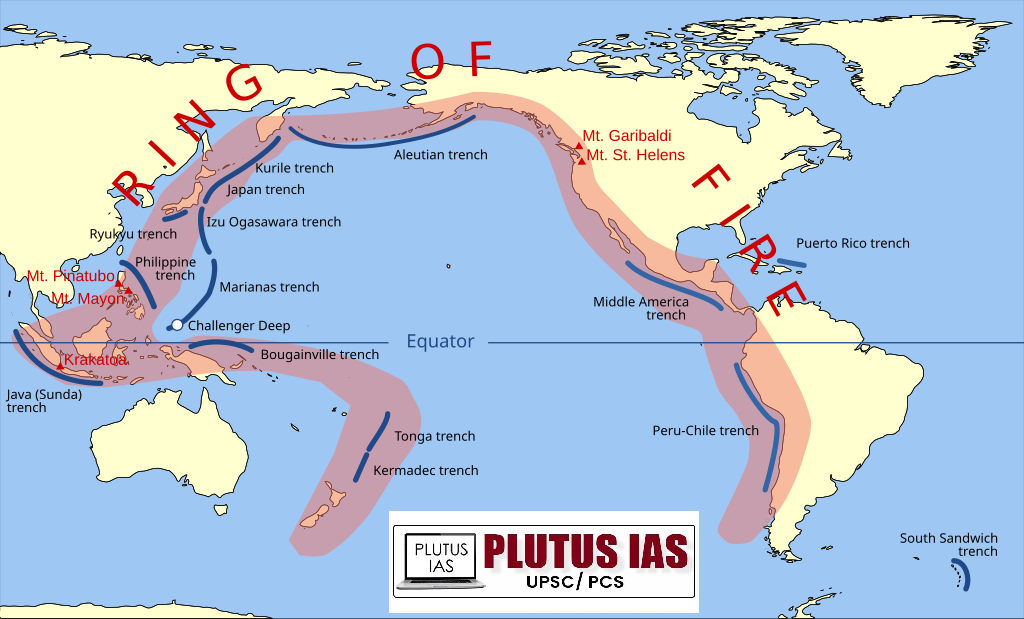26 Dec Powerful Earthquake Strikes Vanuatu, Tremors Felt Across the Islands
SYLLABUS MAPPING:
GS-3-Environment-Powerful Earthquake Strikes Vanuatu, Tremors Felt Across the Islands
FOR PRELIMS:
What is an earthquake, and What is the primary cause of most earthquakes?
FOR MAINS
What is the significance of the Pacific Ring of Fire in terms of earthquake occurrence and its impact on surrounding regions?
Why in the news?
Triggering factors:
1. Tectonic Plate Movements: Earthquakes occur when plates collide, slide past each other, or move apart along plate boundaries (convergent, divergent, and transform boundaries).
2. Volcanic Activity: Magma movement beneath the Earth’s crust creates pressure, leading to volcanic earthquakes before, during, or after eruptions.
3. Human Activities: Human activities can also trigger earthquakes. Mining causes stress in rocks, potentially leading to small tremors. Fracking injects fluids into rocks, causing faults to slip and induce seismicity. Reservoir-induced seismicity occurs when large dams and reservoirs alter pressure on the Earth’s crust, sometimes triggering earthquakes
4. Faulting: Sudden movement along faults in the Earth’s crust causes earthquakes.
5. Isostatic Rebound: As glaciers melt, the Earth’s crust adjusts, triggering small earthquakes.
6. Overburden Pressure: Accumulation of layers of rock or sediment can cause stress that results in earthquakes.
7. Cave or Mine Collapse: The collapse of underground cavities can trigger small tremors.
8. Meteorite Impacts: Large meteorite strikes can create seismic waves.
Regional distribution:
1. Pacific Ring of Fire: The most active region around the Pacific Ocean, with frequent quakes due to plate boundaries. (e.g., Japan, Indonesia, Chile)
2. Himalayan Region: Earthquakes caused by the collision of the Indian and Eurasian plates. (e.g., Nepal, India, Pakistan)
3. Mid-Atlantic Ridge: Divergent boundary where plates pull apart, triggering quakes. (e.g., Iceland)
4. Alpide Belt: Earthquakes due to the collision of African and Eurasian plates. (e.g., Italy, Turkey, Iran)
5. San Andreas Fault (California): Transform fault between the Pacific and North American plates. (e.g., California, USA)
6. Anatolian Fault (Turkey): Transform fault between the Eurasian and Arabian plates. (e.g., Turkey)
7. Indian Ocean: Subduction zones around the Indian Plate cause frequent earthquakes. (e.g., Indonesia, Sumatra)
8. East African Rift Zone: Divergent boundary where the African continent is splitting. (e.g., Ethiopia, Kenya)
9. New Madrid Seismic Zone: Intraplate earthquakes in central USA. (e.g., Missouri, Arkansas)
Why is it more prevalent in the Pacific Ring of Fire?
1. Tectonic Plate Boundaries: The Ring of Fire is surrounded by multiple convergent, divergent, and transform plate boundaries where plates interact:
Convergent boundaries: Plates collide or one is forced beneath another, leading to subduction zones, which are prone to earthquakes (e.g., Japan, Indonesia).
Transform boundaries: Plates slide past each other, causing friction and earthquakes (e.g., California’s San Andreas Fault).
Divergent boundaries: Plates pull apart, creating tension and seismic activity (e.g., the mid-ocean ridges).
2. Subduction Zones: Many of the Pacific Plate’s boundaries involve subduction, where oceanic plates are pushed beneath continental plates. This generates huge amounts of seismic energy, triggering powerful earthquakes and volcanic eruptions (e.g., the 2004 Indian Ocean earthquake).
3. Volcanic Activity: The Ring of Fire is known for volcanic activity, which often accompanies earthquakes. As magma moves beneath the Earth’s crust, it can cause the crust to crack, triggering earthquakes.
4. Frequent Plate Movements: The constant movement of the Pacific Plate, the largest tectonic plate, against neighbouring plates creates continuous stress, making the area highly seismically active.

Consequences of the earthquake:
| Consequence | Description |
|---|---|
| 1. Ground Shaking | Immediate shaking caused the collapse of buildings, bridges, and infrastructure, leading to fatalities, injuries, and significant damage. |
| 2. Surface Rupture | Cracks or displacements in the Earth’s surface that damage roads, railways, pipelines, and buildings. |
| 3. Tsunamis | Underwater earthquakes displace large volumes of water, creating massive waves that flood coastal areas and cause widespread destruction and loss of life. |
| 4. Landslides | Earthquakes trigger landslides, especially in mountainous areas, burying homes, roads, and infrastructure. |
| 5. Fires | Broken gas lines, electrical failures, and damaged infrastructure lead to uncontrollable fires. |
| 6. Infrastructure Damage | Collapsing buildings, bridges, roads, and communication systems, hindering rescue efforts and prolonging recovery. |
| 7. Economic Impact | Massive economic losses due to the destruction of homes, businesses, infrastructure, and long-term economic disruption. |
| 8. Human Displacement | Thousands of people are displaced, often living in temporary shelters with limited access to food, water, and medical services. |
| 9. Environmental Damage | Damage to ecosystems, disruption of water supplies, and adverse effects on wildlife habitats. |
Conclusion
Earthquakes are natural disasters caused by the sudden release of energy in the Earth’s crust. They occur primarily along tectonic plate boundaries, with the Pacific Ring of Fire being the most seismically active region due to its numerous plate interactions, including subduction zones, transform faults, and volcanic activity. The consequences of earthquakes can be severe, affecting both human life and infrastructure, causing economic loss, environmental damage, and psychological trauma. While the causes of earthquakes are diverse—ranging from tectonic plate movement to human activities—their regional distribution highlights the need for better preparedness, especially in high-risk areas like the Pacific Ring of Fire.
Download Plutus IAS Current Affairs (Eng) 26th Dec 2024
Q. Which region is known as the most seismically active due to frequent tectonic plate movements and subduction zones?
A. Himalayan Region
B. Mid-Atlantic Ridge
C. Pacific Ring of Fire
D. New Madrid Seismic Zone
Answer: C
Mains Question:
Q. Discuss the primary causes and consequences of earthquakes, with a special focus on why they are more prevalent in the Pacific Ring of Fire.
(250 words, 15 marks)





No Comments